In the past year artist Andrew Schoultz made the move from San Francisco to Los Angeles and curated two-group shows (including a 70-person group show with Patrick Martinez) so needless to say, Schoultz stays busy. He took some time out to sit down with 1xRUN writer and photographer Miya Tsukazaki for an in depth Q&A as he takes us on a quick tour of his studio space and much more. Read on for the full story…
I first met Andrew Schoultz in 2014 at Pow! Wow! Hawaii where he instantly struck me as being the teddy-bear-type, but a wildly complex one – a little rough around the edges with a glimmer of mischief and an almost protracted, yet deep-rooted point of view. It wasn’t until we made the drive from Oahu’s North Shore to Honolulu, that he gave me a glimpse into this bubble of beautiful chaos, or all that is Andrew Schoultz. We made small talk about his frustration of being away from his wife and son, skateboarding, and what inspires him. Inevitably, he brought up his infinite obsession (unbeknownst to me at the time) with all the “fucked up shit” going on in the world. We chatted for the entire 45-minute drive. He expressed his conviction that society is “rigged,” and explained how he spiraled himself into a decade-long trip to explore and understand what lurks inside the rabbit hole – the same spectrum of social issues repeatedly embedded in his artworks. As I listened, I was at a loss for any sort of thoughtful, legitimate feedback. A light bulb went off. We’d exceeded the bounds of small talk territory. In an instant, I realized that behind the whole tortured-badass façade stood an immeasurable passion for life and humanity.
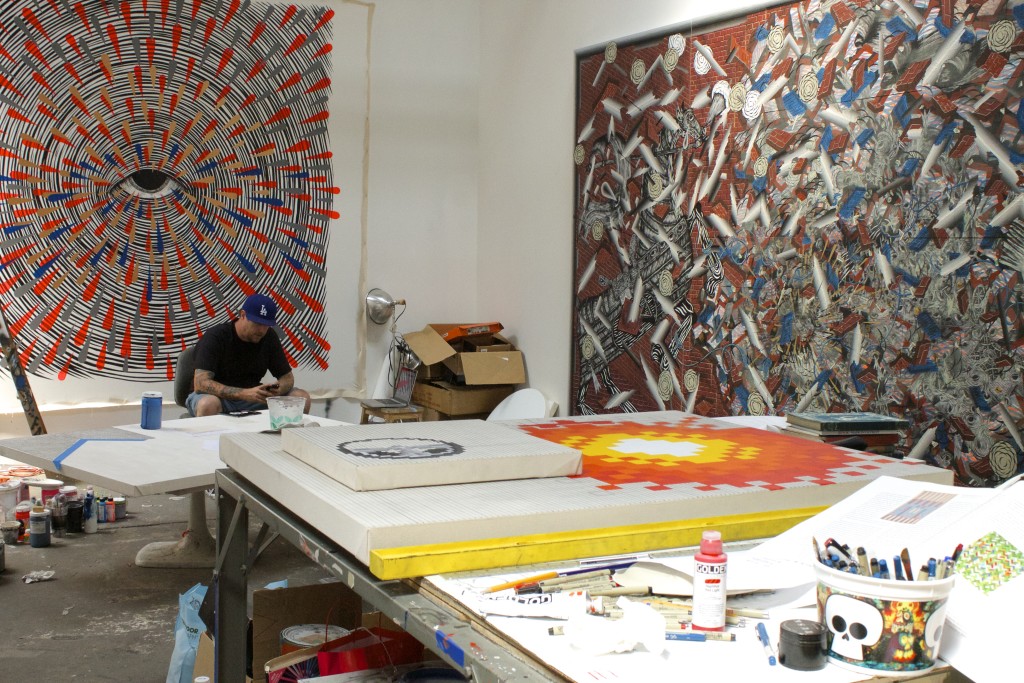
In pursuit of becoming a full-time artist art, Schoultz left Milwaukee twenty years ago and moved into a San Francisco “hallway.” Since then, he has gone on to thrive as a fine artist, and you better believe he’s put in some time on the streets too. After two decades in San Francisco, Schoultz arrived at a crossroads, facing a life-altering decision. Looming gentrification issues in San Francisco prompted him to consider whether or not it was worth it “to continue to fight the good fight,” while carrying a perpetual dark cloud over his head. Not willing to sacrifice his family’s well being, Schoultz moved his wife, son, and studio south to Los Angeles. I was able to catch up with Andrew in his new studio space and talk about his recent move. We picked up right where we left off, the last time we saw each other on that windy road in paradise.
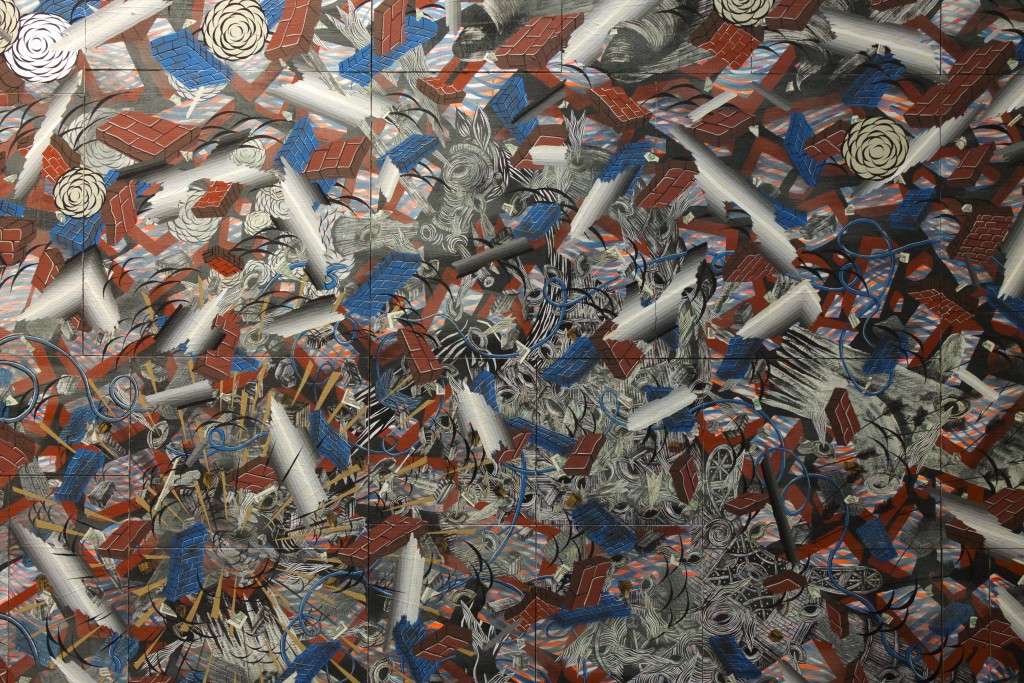
Welcome to Los Angeles, buddy. How do you like being down south? How has the transition been so far?
Well, moving to Los Angeles really wasn’t much of a stretch because I’ve been coming down here and doing projects for the last 12 years. It was an easy transition because it was already kind of a “home away from home” and I knew the lay of the land. Plus, it’s a complete upgrade. I doubled my space for half the price of what I was paying in San Francisco. It’s awesome because I share the studio with six other artists, including Patrick Martinez. No one is really around and we have a parking lot, loading docks, and a lot of common space. If I want to go outside and build something, I can. My new studio provides more possibilities – ones that would be nearly impossible in San Francisco because you’re so confined.
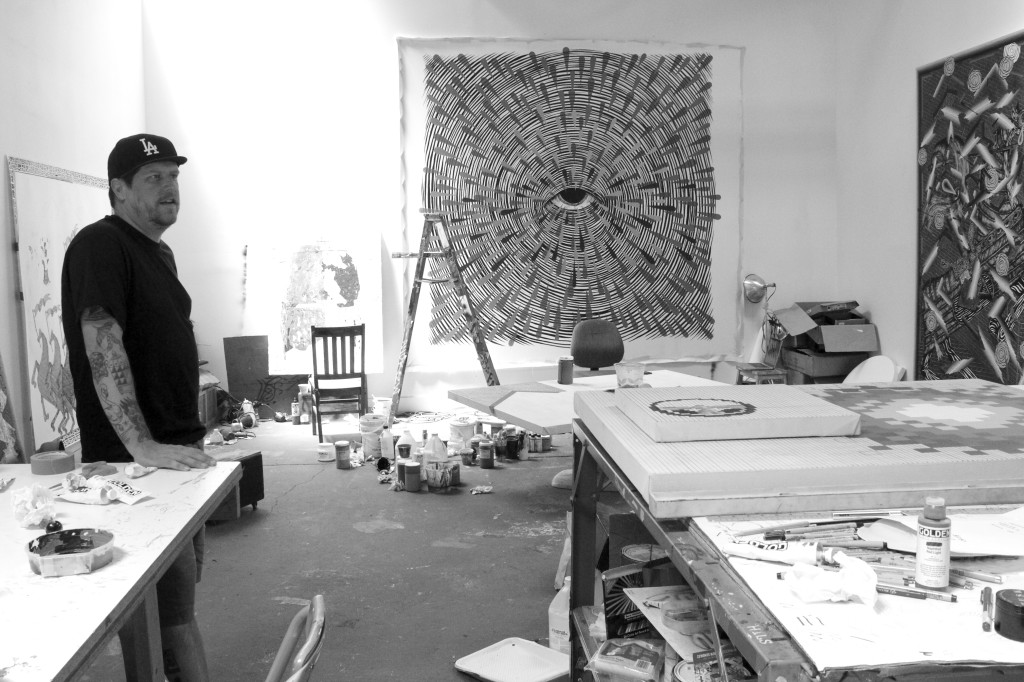
Yeah, that makes complete sense. By the way, this is a pretty interesting neighborhood. I wouldn’t have even known this was an art studio driving by.
Yeah, it’s great because the location is just far enough from the Downtown LA Arts District, which is currently being gentrified. I like it here because there are all kinds of galleries popping up and all of this unassuming, crazy shit happening right around the corner. Retna is right up the street, my buddy has a pizza place nearby, and I felt like this would be a cool area for me to be in because it is only about 11 miles from my house. I had no idea I was moving into an unassuming hotspot for art, but I still feel like it’s far enough away so I don’t have to worry about getting kicked out anytime soon.
The people that run the building are artists themselves who invested money in the building to make it a studio. No one is trying to make money or be landlords – all of the artists here are simply sustaining it as an art studio. I was lucky enough to find it on Craigslist prior to moving down to LA. I checked out the area and based it off of how close it was to my house. The only shitty thing is that even though it’s 11 miles away, LA traffic can make the trip anywhere from 15 minutes to two hours.
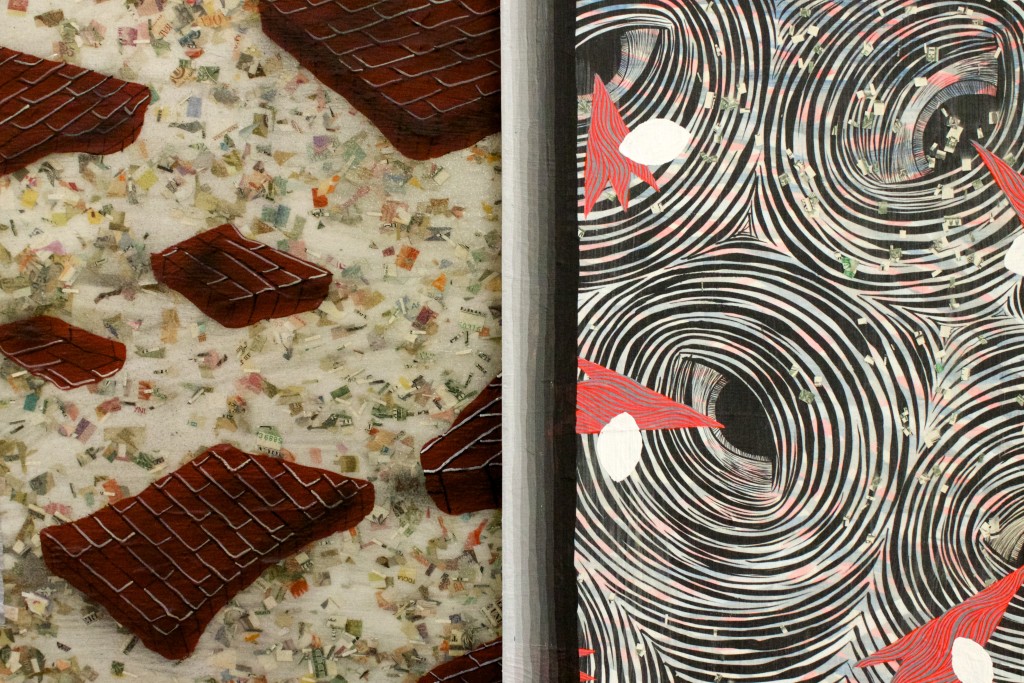
Is that LA’s main downfall? Let’s just get all of the NorCal vs. SoCal gripes out now…
Well, in LA you have to be completely dependent on a car. That’s the main drawback. In SF, you can bike and skateboard anywhere, which was important to me because health is a part of my lifestyle. On the flipside, I do skateboard tons more now. I also feel that there’s more possibilities for artists in LA than SF.
Really? It seems like there are still quite a bit of artists holding it down in SF. What’s the real story behind you leaving?
San Francisco just doesn’t feel like an “art city” anymore. I watched my friends and fellow artists get kicked out of their studios to make room for the tech industry people. Seeing the blunt illustration of artists, and what I really love about SF, get pushed out to make room for this new industry led me to the point that I didn’t want to be there. For the type of overhead you need to live there, it wasn’t worth all the anguish and money that you needed to exist. I could feel the stress because everyone was always talking about getting kicked out or that they knew someone that got kicked out of their space. I was constantly walking around with a looming paranoia…and I was angry about it. I didn’t want to be angry about it anymore. I wanted to do something about it.
All of this led to me moving my family down to LA and so far, it feels like a much better place. East LA feels like how SF felt in the early 2000’s. You’re at the park, or you’re at the bar, or whatever and the average people you are running into are creative types. I take my kid to the park and start talking to randoms and I ask them what they do and one guy says he’s in a band, and the next says he’s started a pop-up restaurant. It’s like everyone you run into is a creative type. In SF, the norm is working at Google or Cisco Systems. It was a hard decision to leave but it isn’t the city that I once knew, so it was bittersweet.
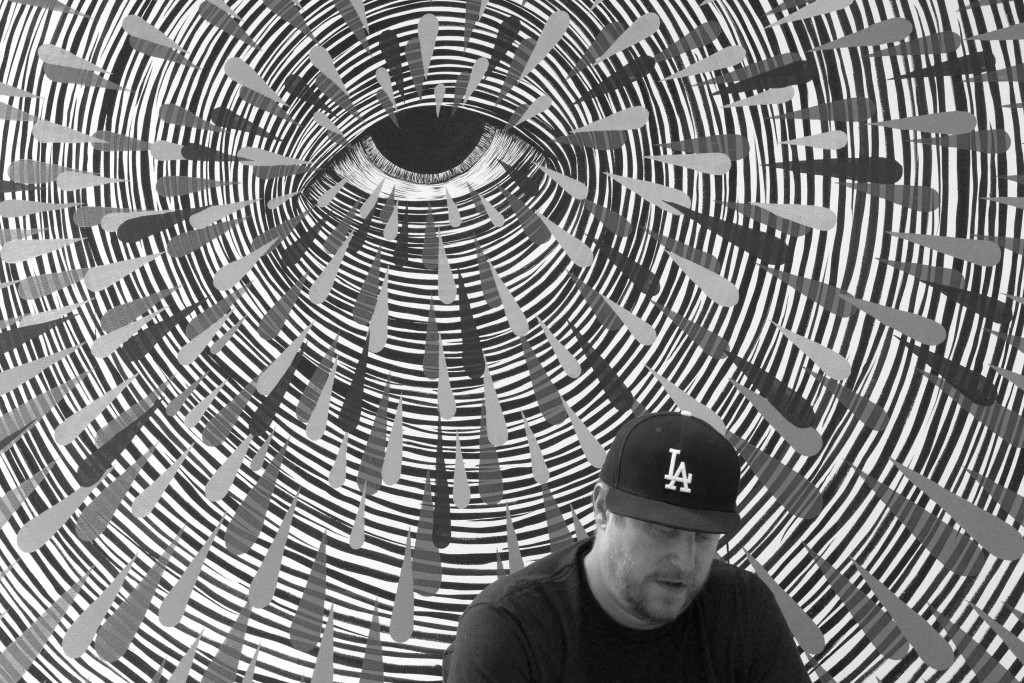
That’s pretty intense. I feel like a lot of people would have a hard time flat-out admitting that, especially on the record, do you want to elaborate?
A big part of me moving here was that I wanted to surround myself with like-minded individuals. It was starting to feel like the community I had grown to love in SF was dwindling down and no longer existed. I know I may be rambling, but this is important to talk about. I don’t want to simplify it, because simplifying it sounds like I just gave up on the city, which is definitely NOT what happened. I invested my whole being and everything I had into that city, and that city turned into something that I no longer wanted to support anymore. It was really sad for me to see all of this happen.
To a certain extent, a lot of people claimed they would stay in SF and “fight the good fight” and they had all this pride about it. But, all you see is the same people getting pushed out more and more. I respect those people, but I just felt like the odds were so far against us. If you really analyze how SF has ended up in this state of being, it’s all about politics and propositions that have been set in motion a decade or more ago. It’s like turning a fucking oil tanker around in a puddle – you can sit there and have wishful thinking, but meanwhile you’re just going to end up dealing with heartbreak. I realized that this wasn’t my fight to fight anymore. I had invested everything I had into a place and into a community that I believed in… it was time for me to go.
It seems to be a recurring theme with a lot of nooks that were charming and cool ten or fifteen years ago. I feel like as we get older the G-word is far too common.
The irony of the whole situation, whether you’re talking about Brooklyn, Oakland, etc., is that “gentrification” always comes up. What most people don’t realize is that gentrification begins with the artists! Artists move to a neighborhood because it’s cheap and they need space and then they make it a cool place to live. Before you know it, you have cafes and coffee shops popping up and then that makes it appealing to real estate speculation. In the blink of an eye, real estate goes up and they push not only all the artists out, but also the folks that were living there for years and years and years before the artists came in. That’s the most troubling conversation you can have about gentrification.
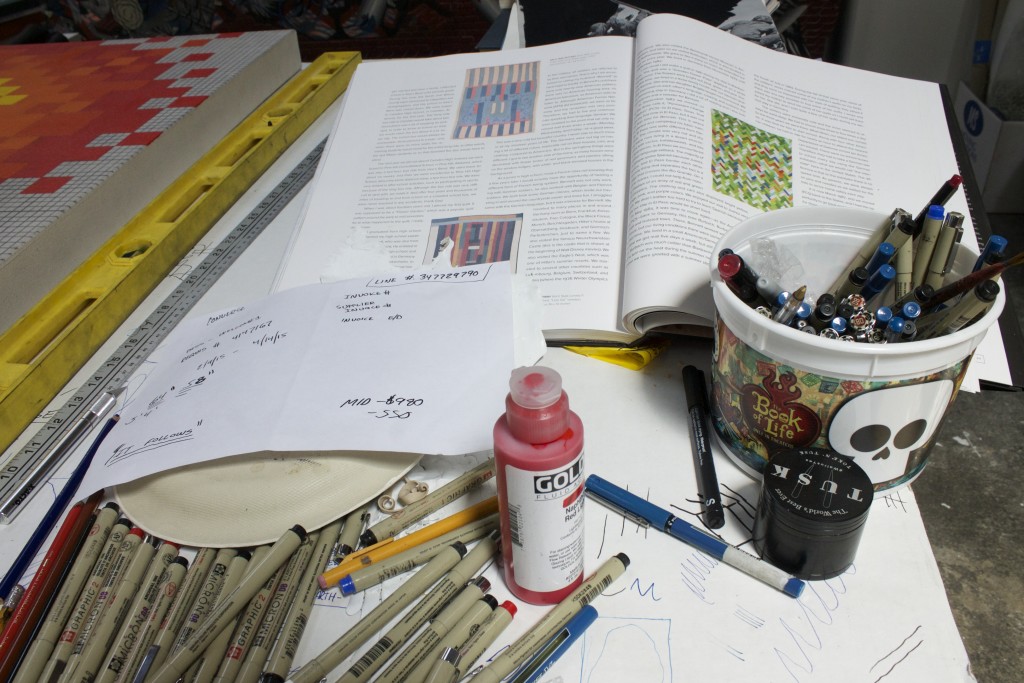
Wow. I don’t ever think I’ve heard an artist take responsibility for having a role in gentrification. Speaking of artists birthing the whole G-word debacle, I’m heading to the Mission for a project and I feel like this conversation is oddly relevant. Isn’t the Mission one of the most primo examples of this?
Well, it WAS one of the most culturally diverse parts of SF. Then the artists came, and some of the first Chicano murals painted in the US were in the Mission – it’s where it all began. The cultural diversity and cool things going on made it appealing for all kinds of people to want to live there. Then all these people show up. They don’t have any connection to the art, they don’t have any connection to these cultures, they just want to live in their big house a block away from Delores Park and they don’t care how much it costs, what the repercussions are, or how it affects the community.
This is a gray area because you can ask yourself, ”What is advancement?” Does advancement mean really fancy restaurants and everything is super expensive and there are rich people everywhere? I don’t believe that. I think a true successful society is one that exists on all planes. Diverse economic status, diverse culture, diverse everything – that’s the most thriving kind of society or community that can exist. And that’s the problem with gentrification. It’s sort of like a snowball rolling down a hill. Artists want to complain that they’re getting kicked out of their studios, but on some level I think we have to take responsibility for the gentrification as well.
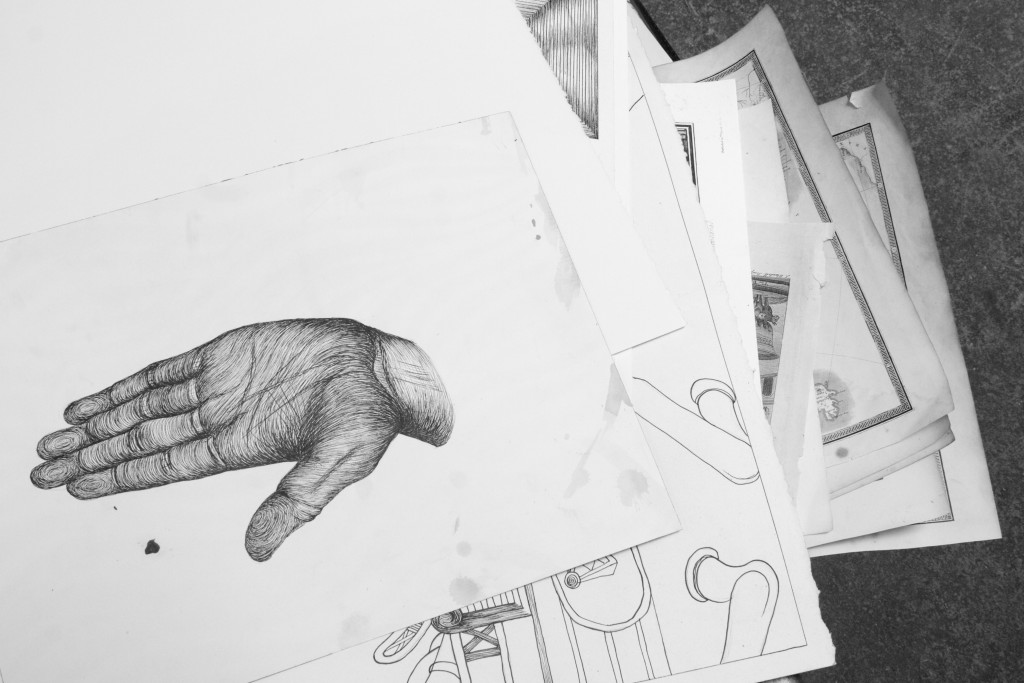
What was it like when you first moved to SF? Did you always feel like you would eventually be displaced?
I wasn’t an artist that moved to SF because it was cheap. Coming from the Midwest, SF just never seemed cheap to me. I moved into a hallway in 1997 that I paid $200 for, and at the time it seemed crazy, like “I have to pay $200 to live in a hallway?!” You know, you could get a whole flat in Milwaukee for 700 bucks and split it with 5 friends. But on another level, once you live there for a while, you get used to the economics of the city. If artists move into neighborhoods and invest themselves into the community and make themselves accessible, then they have a stake in that community. I’m not eliminating the fact that it sucks when people get displaced. That’s the bottom line. Displacement anywhere in the world is terrible.
From another perspective, we live in America and this is a privileged society. Problems like gentrification – they’re “privileged peoples” problems. It’s good to reel it all back in and put it into perspective.
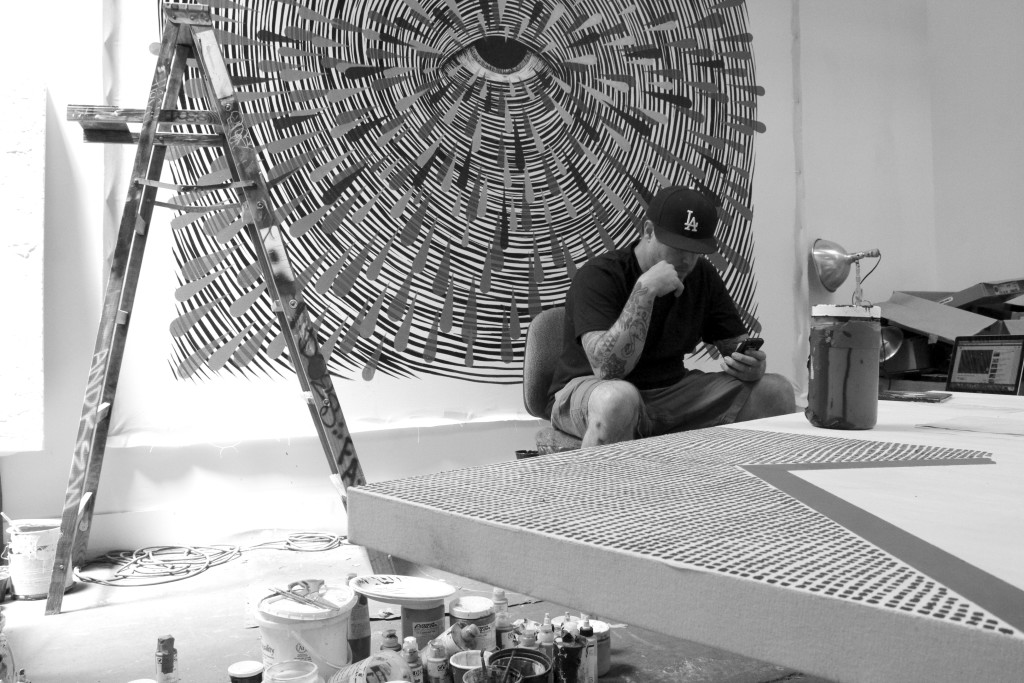
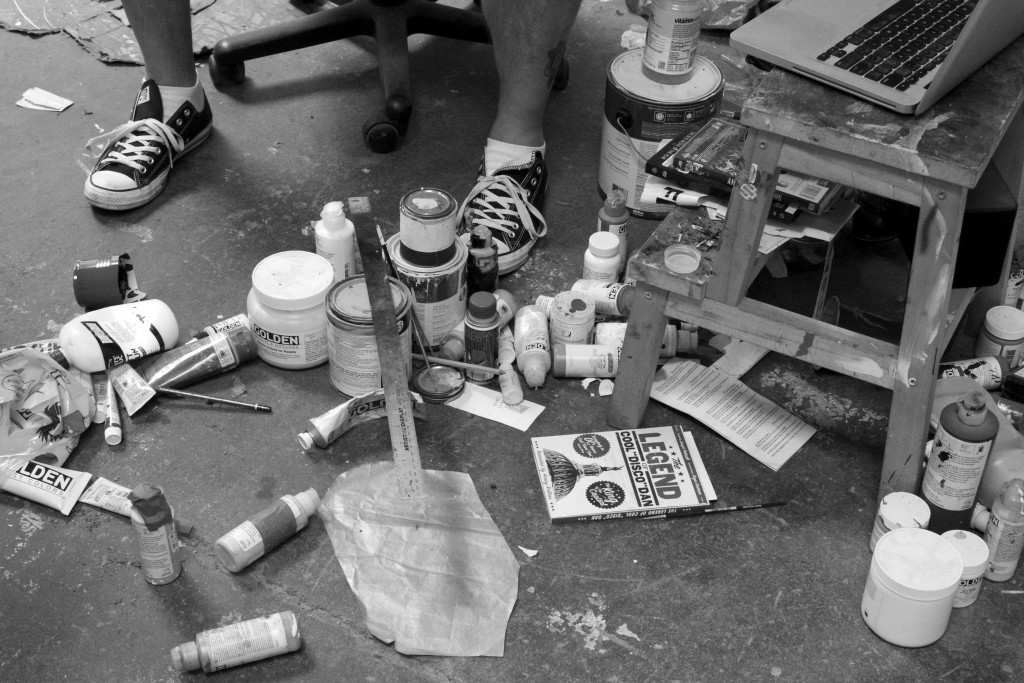
That’s true (cue hashtag FirstWorldProbz). A lot of these feelings and beliefs translate into your work and are very powerful. Is this intentional?
There’s a lot of social politics in my work, a lot of things that have to do with duality, globalism, the world’s economy, and darker things for that matter. Simply put, a lot of my work relates to history, and how history is in constant repetition. Moving forward, my process is changing a lot aesthetically, but conceptually it focuses on these same issues. I get so fixated on all of the fucked up shit going on in the world that it’s hard for me to change gears and go “Okay, now I’m going to make something about this happy thing” or devoid of this “trip” I’ve been on, so to speak. It’s hard because the older I get, I just become more focused on knowing about how we live in this society that is sort of rigged and ruled by greed. You can talk about the environment, you can talk about war, you can talk about the economy, you can talk about human rights, but all of these things are all related so closely that you can’t really isolate one of them and not talk about all of them.
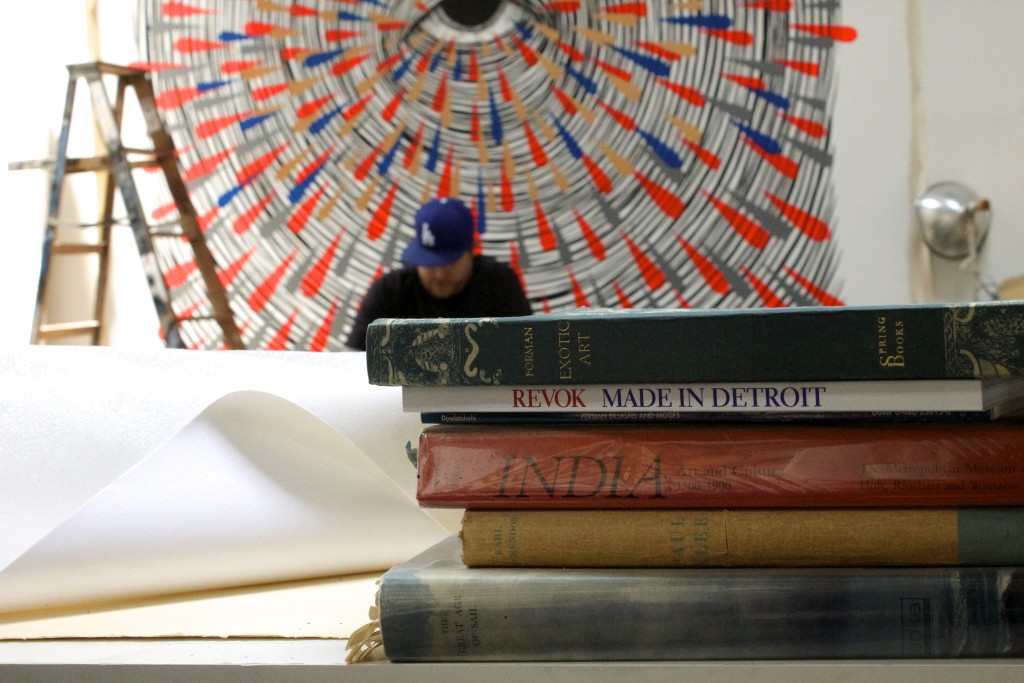
I think that’s part of what makes your work so intriguing. Not to mention the textural component, I can’t help but compare it to all of the layers and layers of “fucked up shit” in the world we’ve been talking about.
Yeah, process-wise I’m into layering and layering and layering and mark making. It’s a very laborious process. I’m very obsessive-compulsive with my work and everything that I make takes SO long. Content-wise, it just seems like an impossibility to think about all of these problems with society and try to vocalize it in any sort of small or brief manner. In my work, there are narrative qualities that I have, but it’s not a narrative like, “Look at the picture – this means this, or that means that,” it’s very much open-ended to a viewer’s impression or what relationship they make to the images they see. Some of these images are loaded and have direct meanings, but that’s the “trip” I’ve been on for the last ten years. There’s a lot of repetition and continuation of this ongoing theme because I am infatuated with these issues that keep snowballing.
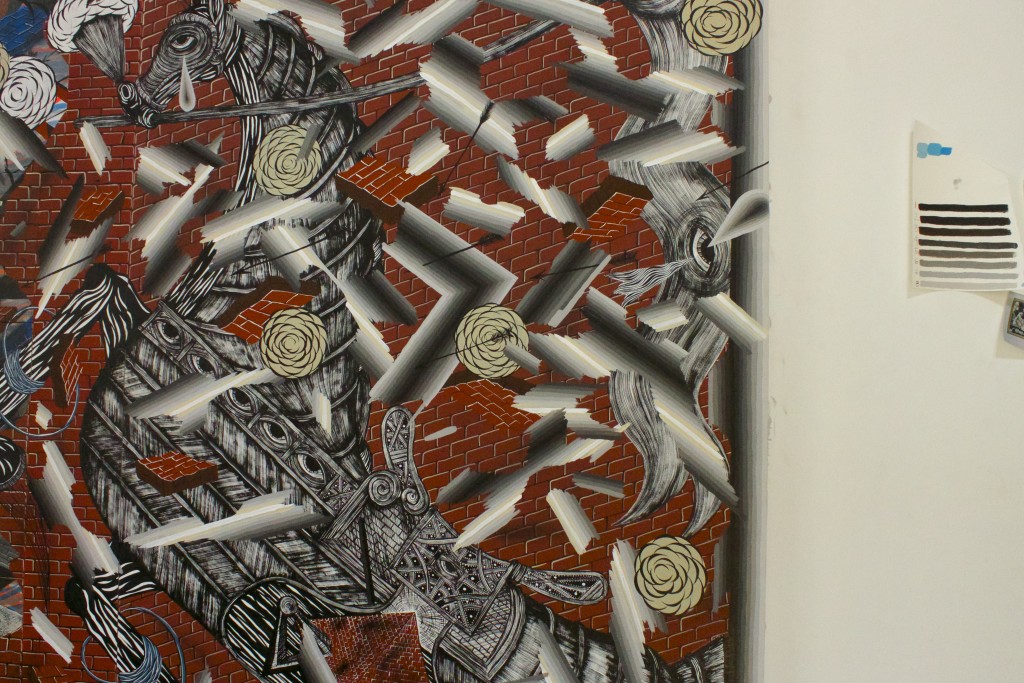
Has your creative process always been this way?
To be fair and honest, a lot of my work is in a transitional phase. I have a backlog of my iconic characteristics that can keep recurring within different contexts. Now, the problem is that I get a commission to make a painting that looks something like my iconic or quintessential work. So I’m constantly trying to develop new work, but then I also constantly have to go back and make work that looks like my older works. There’s always this catch-22. Now it’s changing in a stream-of-consciousness kind of way, like you would experience the Internet and the randomness of images.
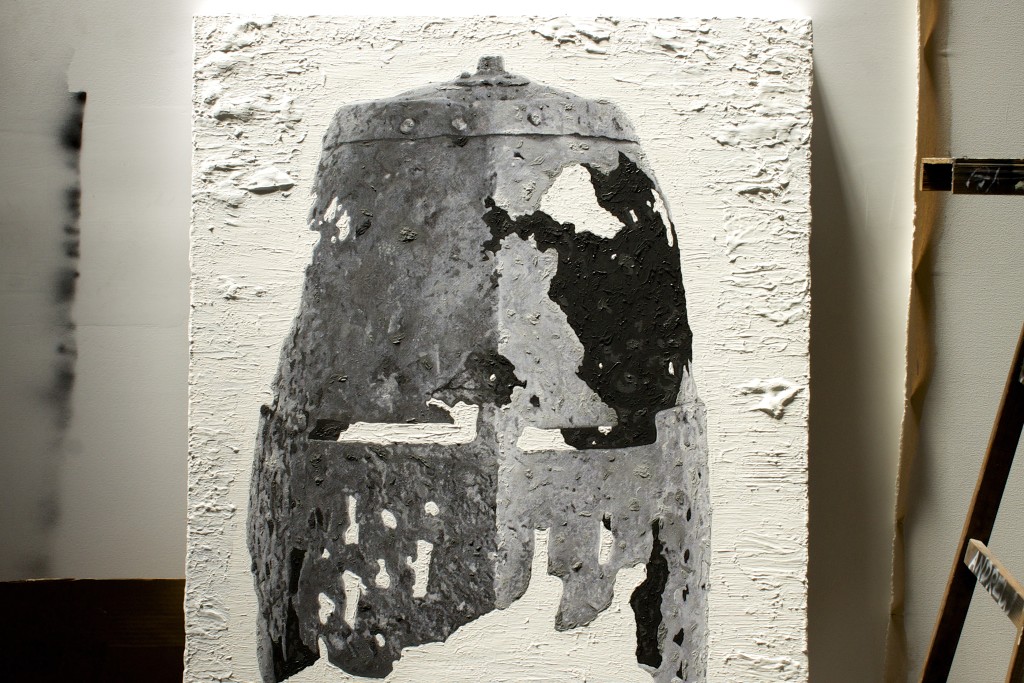
So are commissions not really a high priority?
Commissions are a necessity because I got bills to pay. Being a full time artist is a delicate balance, where you might not get to always do exactly what you want, all the time. Reality factors in. Even though my work is in transition and I am pushing in other directions, this doesn’t mean that I am dropping or moving on from previous work. It just merely means that sometimes it’s hard to be working in new directions when you are constantly trying to make sure that you can pay the bills. For example, being an artist means that at times you may have a lot of money coming in but you also have to spend a lot of money to maintain your practice, as well as pay the rent and put food on the table. Again, privileged problems, but still, the reality of being an artist.
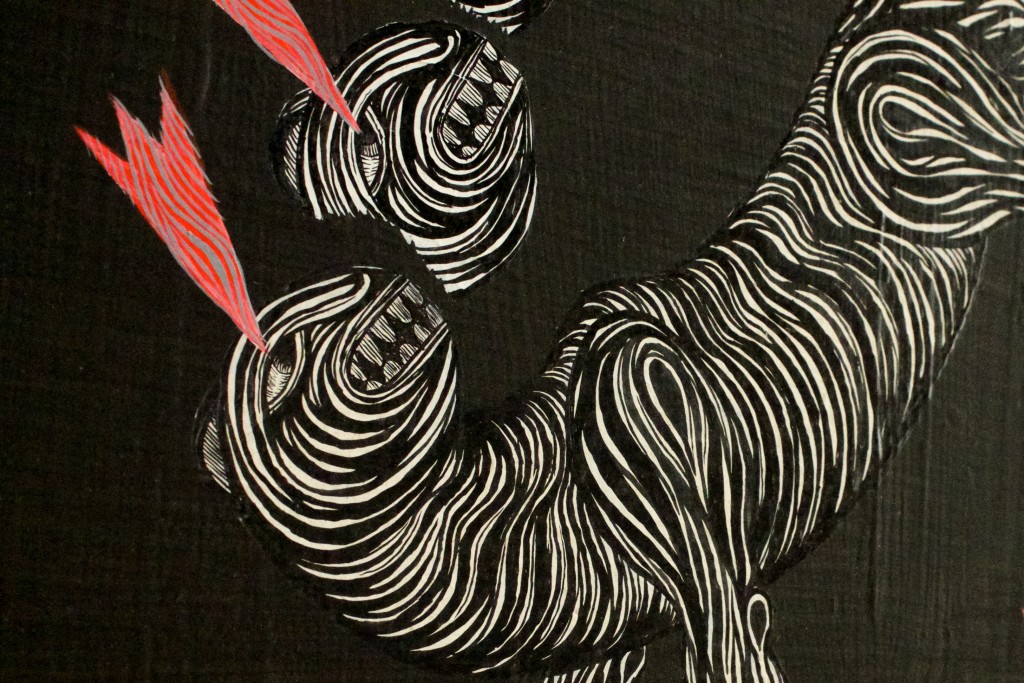
Right now I’m trying to figure out if there’s a more immediate way to produce some of my work so that everything I do doesn’t have to be this neck-breaking process that just goes on and on and on and on. For lack of a better description, not everything has to weigh so much. That’s the way that I am trying to deal with everything I was just talking about. Not everything has to be so hard.
So what’s in the cards for you in the next few months?
In the studio, I am constantly trying to produce, produce, produce because I never really have stuff. Even if I didn’t have some imminent deadline, I have galleries that I work with that I need to produce for so that they have my work in their inventory. I have a solo show planned for this September with Mark Moore Gallery in LA, a mural in Echo Park this month, a mural in the Long Beach Museum of Art in June, and a mural at Fort Wayne Art Museum in July. I also just curated a 70-person group show with Patrick Martinez featuring still life paintings, which opened May 22 in SF. I stay busy.

-1xRUN
To stay up to date on Andrew Schoultz visit his website and follow him at @aschoultz.
Words & Photos by 1xRUN Contributing Writer and Photographer, Miya Tsukazaki. Follow her at @miyaeuca.